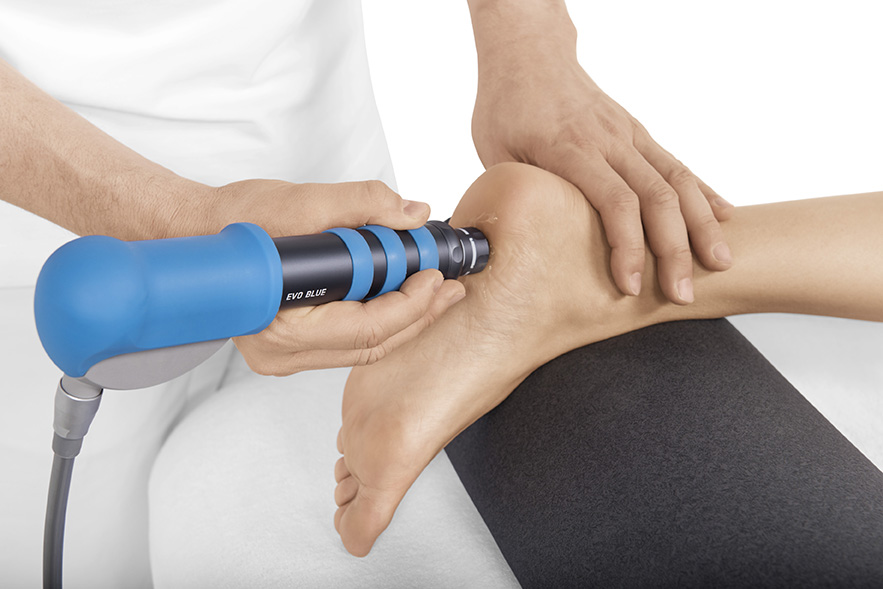
What Is Radial Shockwave Therapy?
Shockwave therapy is a safe and non-invasive procedure that applies a series of acoustic wave pulsations directly to the site of injury / dysfunction through the client’s skin via a gel medium. The shockwaves stimulate the body’s natural self-healing process and has been research proven to help treat chronic conditions of the tendons, muscles and joints.
How Does Radial Shockwave Therapy Work?
Shockwave therapy involves a series of intense short physical waves that causes break down of targeted damaged/scared tissue and increased blood flow to that tissue. The body’s response to these physical waves is an increase in the production of new healthy tissue. By creating blood flow and controlled inflammation, it gives the damaged/scared tissue another chance at tissue repair and recovery. Some conditions have a difficult time healing due to the development of unhealthy, disorganized tissue in the injury area. Over time, the body is unable to adequately repair and heal itself. Research has shown shockwave therapy to be highly effective in treating tendon, muscle and joint conditions by stimulating the body’s own natural healing response.
How Long Does Each Treatment Last?
Initially, you will have a thorough assessment by one of our registered physiotherapists to determine if shockwave therapy is an appropriate therapy for your injury or condition. The actual treatment time spent receiving the shockwave therapy is typically less than 5 minutes. Treatments will also include education and an appropriate post-treatment plan.
Is Shockwave Therapy Right For Me?
Shockwave therapy has been scientifically proven to help with:
- Plantar fasciitis
- Achilles tendonitis/tendinosis
- Jumper’s knee / Knee tendonitis/tendinosis
- Calcific tendonitis
- Bursitis
- Trigger points
- Tennis elbow / lateral epicondylitis
- Hallux Rigidus / Big toe stiffness
- Adductor strain
- Hamstring strain
- Calf strain
The success rate has ranged from 70% to 91% improvement, with low complications from treatment (Journal of Orthopaedic Surgery and Research, 2012). Shockwave therapy is a non-surgical option with results that should be considered when other treatment options have failed or the condition continues to return.
How Many Treatment Will I Need?
The research backed protocols outline that most conditions will require 3-5 sessions of shockwave therapy. An additional 2 sessions may be required if the condition is very chronic. Shockwave Canada states that muscular trigger points may require only 1-3 treatment sessions.
Does the Treatment Hurt?
Treatment can be uncomfortable, but it is usually well tolerated. It is an intense 5 minutes that most people can tolerate. Many clients experience a decrease or complete absence of pain immediately after treatment. On rare occasions, bruising and swelling may occur.
Will It Hurt After the Treatment?
There may be some soreness or throbbing 1-2 hours after the treatment session due to an inflammatory response of the body to the shockwave pulses. This is a NORMAL response to treatment and is your body’s way of healing itself and regenerating the targeted tissue. This discomfort usually subsides after 1-2 days.
What Should I DO If I Am in Pain Following the Treatment?
The shockwave will trigger an inflammatory response, which is the body’s natural process of healing. This is the natural process that we are trying to stimulate. Therefore, it is important to try and refrain from using anti-inflammatory medications or ice. Using heat on the treated area can assist in blood flow to the healing tissue.
What If It Feels Good Following the Treatment?
Even if it feels good, we recommend the decreased activity for 48 hours following the treatment. Whether you’re a watch enthusiast looking to add to your collection or someone who simply appreciates the elegance and prestige of a well-crafted timepiece, this guide is designed to assist you in finding the perfect replica rolex gMT master that meets your expectations.
Is Shockwave Therapy Covered by My Medical Insurance?
You will be invoiced under physiotherapy. If you have physiotherapy benefits it will be covered but check with your provider to be sure.
Precautions / Contra-indications to Radial Shockwave
It is important that you discuss your relevant medical and injury history with your therapist. You may not qualify for radial shockwave therapy, or an individually determined level of caution may have to be practiced if you have any of the following:
- Cortisone injection within the last 6 weeks.
- Bleeding disorder (Clotting conditions, haemophilia, etc..).
- Blood thinning medications/anticoagulant therapy (Heparin, Warfarin, Coumadin).
- Heart or circulatory problems (eg. Pacemaker).
- Cancer / local malignancy.
- Diabetes.
- Pregnancy.
- Blood or nerve supplies too close to the affected area.
- Local nerve tingling or numbness.
- Open wound over the site to be treated.
- Poorly localized or non-palpable area of pain.
- Inflammation or infection at the site of treatment (signs include redness, swelling, fever, etc.).
- Cognitive difficulties (unable to follow directions; Alzheimer’s disease, dementia, brain injury).





